Is This the Working Man's Stage 3 Kit?
Dave Niesen decided to upgrade his bike with a 95CI kit, drop-in cam, and some cylinder head work.
On the HTT there has been lots of discussion about whether the TC2G cams would work with various cylinder head schemes.
Short Block Charlie's Scottsman cylinder head treatment is popular and affordable, so Dave decided to give it a try.
The 'build' looks like this;
| SBC 'Scottsman' head package | |
| 'Wild Things' flat top 95CI pistons | |
| 'Wild Things' TC2G cams | |
| S&S gear drive kit | |
| S&S bearing kit | |
| S-E air cleaner (on the bike already) | |
| White Brothers 'E' Series 2-into-1 exhaust (on the bike already) | |
| Custom Chrome DFO (on the bike already) |
Dave lives in Wisconsin, so he rode his bike over one afternoon (World Class Tuning is 25 miles west of Minneapolis.) SBC shipped the heads to World Class Tuning (us.)
Bob Wright (R&D Performance), shares the building with us and he was going to do the assembly and we would do the tuning.
Dave intended to use his DFO for tuning.
I don't know what, if any performance mods were done to this bike beyond the S-E air cleaner, 'E' series pipe, and Stage 1 Map (assumed because of the 6200RPM limiter.)
The torque is definitely in the 88CI category, and the power is pretty good.
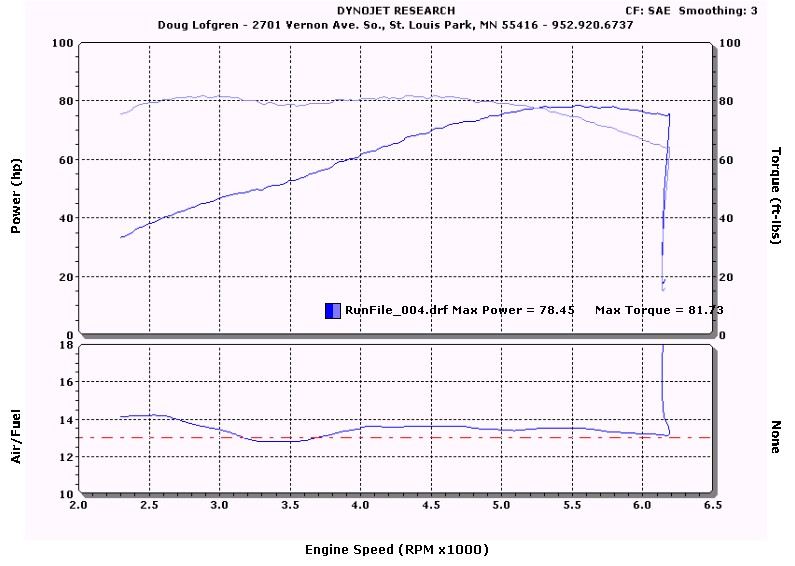
The 'E' Series muffler had 7 discs on it, and the dip in the torque curve at 3500 RPM is pretty typical of too much restriction.
Dave said he adjusted the number of discs for best performance (drivability in this case) and the compromise to the WOT torque shows on the dyno chart.
While Bob was performing the work on Dave's bike, we were testing the 'stock cylinder head', high compression, TC2G bike. Stock Heads
When Dave's bike was finished it was put on the dyno for some heat cycles.
Mike Roland doesn't spend a lot of time at the shop because of all his other duties, but these two projects hold a special interest. So, we did a lot of this testing together that's why all the references are 'we'.
I can only make a guess at which map was loaded on the ECU, but since the rev limit was set at 6200 RPM, I'm assuming that it was the H-D stage 2 map.
The WOT runs with 7 discs (blue) showed good power but the torque was pretty 'soft', so I added 5 more discs to make it 12 (red.)
I added 3 more for 15 total (green) and knew that more wouldn't help.
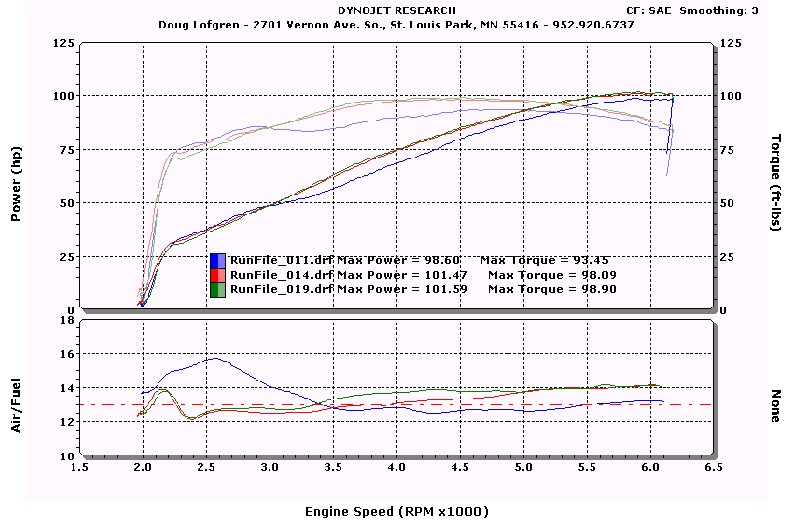
Notice the variation in A/F traces with the back pressure variation and power on the chart above.
After quite a few adjustments to the DFO we found the settings that produced the best WOT power. These were not the best settings for drivability. Since the top-end fuel adjustment was turned all the way up, the adjustments that we could use were the crossover RPM and accelerator pump pots. The DFO can change the fuel by a limited percentage over the existing map values. That is why a map for a lower power combination limits the maximum fuel you can get.
If you were to 'flash' a stage 3 map (f'r instance) there would be more fuel available because the injector times would be longer to support the extra power of the 95CI stage 3 over the 88CI stage 2.
The chart below shows the A/F trace for the front cylinder in red and the rear in blue.
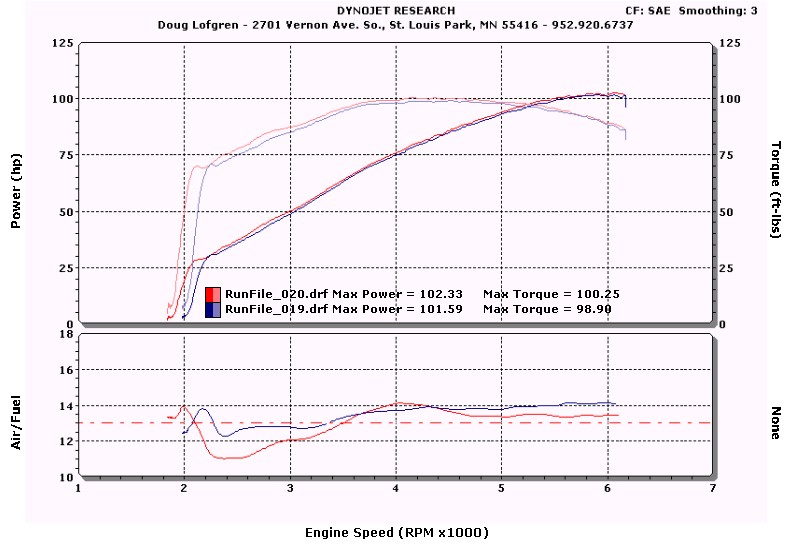
With the cylinder-to-cylinder variation of the chart above, engine output is quite temperature sensitive. In addition, the high end pot was adjusted to the maximum fuel, so the rear cylinder is always going to be lean at WOT 5000-6000 RPM.
To get the best power with the DFO Mike had to add a bunch of accelerator pump fuel and the drivability anywhere except WOT wasn't very good with all that accelerator pump setting, so that was turned down a bit for the test ride.
Mike and I rode the bike after this part of the testing, and it was surprisingly good. Under acceleration it was really good. But, there was a lot of vibration at various throttle settings and RPMs. Idle was rough due to A/F variation from cyl-to-cyl.
The bike just didn't feel as smooth as the previous (hi-comp, stock head) Road Glide I had done.
It must be time for a word about drivability.
For some reason (probably heat) WOT has a fairly broad range of A/F ratios where it doesn't mis-fire. Part throttle (higher vacuum) often seems more sensitive.
As in the chart above, the A/F variations at part throttle have a lot of variation from ideal and from one another. This often causes mis-fires in one cylinder or another (or both), This may feel like normal engine vibration, a cherished trait of Harley-Davidsons, but the touring models, with their isolation systems, should be very smooth.
Below, the chart shows 20% throttle runs. Runs 23 (blue) and 37 (green) are the initial runs checking front (green) and rear (blue) cylinder A/F ratios. You will notice that the power and torque gets very 'jaggedy' beyond 3000 RPM.
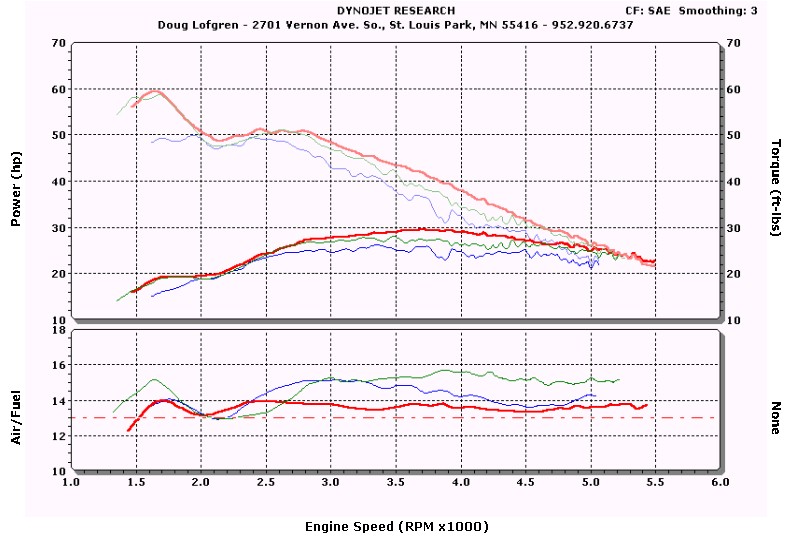
The red trace is the rear cylinder after some adjustment.
This shows the cylinder-to-cylinder variation as well as the mis-fire associated with less-than-optimum A/F ratios.
This is 20% throttle where you might cruise on the highway. If your engine runs ragged, with less power, you will subconsciously adjust the throttle to a point where you get the power that you need, but you can't count on the A/F ratios being any better at 23% or 23% throttle, so you will have vibration.
Back to the search for power
I disabled the DFO and loaded a base file from the Direct Link software. Then, proceeded to create the map that this engine needed.
After a couple rounds of adjustment at all (not 'all' but most) throttle positions on both cylinders, I had a decent A/F map for each cylinder but the power wasn't up to the level it was with the DFO.
Explanation? The DFO started with an original H-D stage 2 map and, obviously, the timing was closer to optimum than the Direct Link map with which I had started.
I changed the ignition maps to roughly the values that I had used with Scott Point's map. Because Scott's was done with the Race Tuner and Dave's was using the Direct Link, I had to change the maps manually rather than 'exporting' and 'importing' them with the Race Tuner.
The following chart shows the DFO run #020 (red), the Direct Link timing maps #041, and the first adjustment #042 (green.)
Clearly the job isn't finished yet.
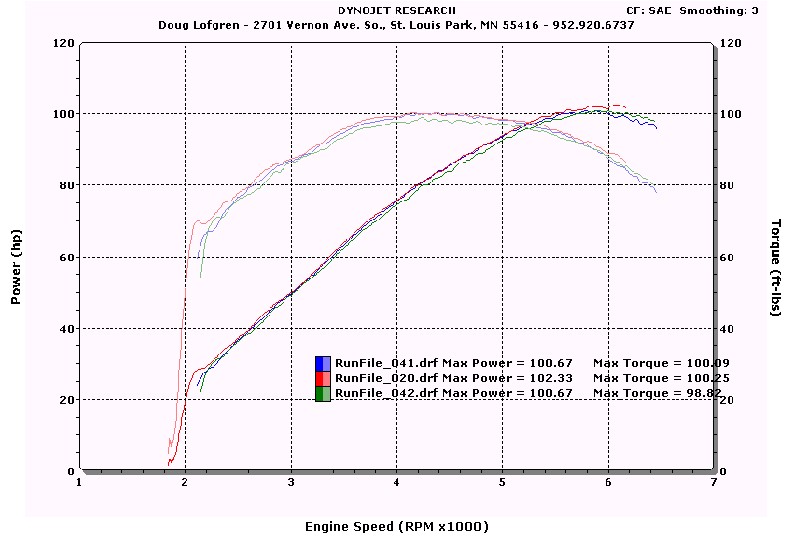
There are no surprises at this point because the timing requirements for Scott's bike with higher compression would be expected to use less ignition advance at WOT. In fact, this engine did respond to more timing.
The final result after a couple rounds of ignition adjustment and one more fuel adjustment is shown below.
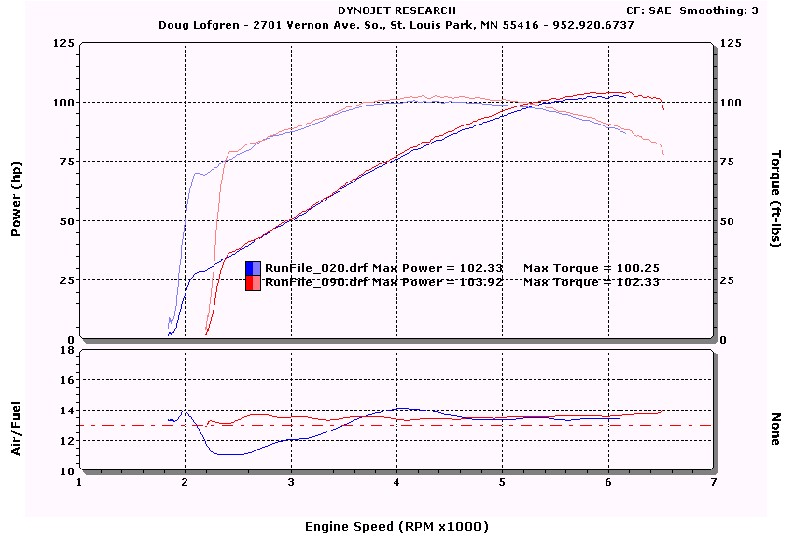
You may also notice that the rev limit has been bumped up just a little. The stage 2 upload has a 6200 RPM limiter and the power wasn't over the peak at that point.
As a matter of fact, Dave took the bike for a test ride when he and his son, DJ, came to pick it up, and came back saying he had hit the limiter hard.
We have taken to doing 5th gear runs so we can have comparative numbers for the folks who do check power in 5th gear. Below is a 5th gear STD corrected run.

Obviously we haven't been paying enough attention to our 'drop-in' cams. With results like this, we are forced to re-think a few of our long-held assumptions. That is what we call 'learning
This is just another confirmation that what you can learn is more important than what you already know.
Go the the 'Reports' page, then scroll down for more and varied reports; Reports